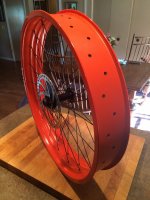ebikedelight said:
wow..this is really complex....no wonder why 99% of bicyclsits dont learn to do this.
ebikedelight, please go to the website that this topic is about here:
http://www.ebikes.ca/tools/spoke-calc.html
Every field is explained in detail in the text under the calculator and diagrams.
http://www.ebikes.ca/tools/spoke-calc.html#hub-settings
http://www.ebikes.ca/tools/spoke-calc.html#lacing-options
http://www.ebikes.ca/tools/spoke-calc.html#results
If you aren't able to read and process written text very well, then part of why we made a dynamic drawing of the laced wheel is so that you can SEE firsthand what all of the measurement parameters are for and what effect they have. So if you are confused about what the spoke offset is, then click in the number to increase or decrease the values and see how that changes the drawings of where the spoke holes are on the rim. It will be abundantly apparent what the number refers to if you just look at how the drawings change when you change the numbers.
Finally, if you have your own spoke threading tool and tons of spare spokes, then best is simply dive into building your first wheel, you could probably have already made the wheel in all the time spent posting all over the forum trying to solicit help! All the parameters and their meanings will be way more apparent when you have a rim and hub in your hands and are lacing up the spokes, and then I think you'll find this all a lot less confusing. If your spokes wind up a bit too long or a bit too short, then either live with it if it's just a few mm or cut and thread some more spokes to get it right.
There's not much more for you to do at this point other than waiting for the rim to arrive and then jumping in.




